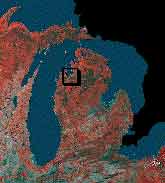|
Rural
Landscape
Not all of the
rural development is simply from families escaping the traditional
urban neighborhoods. Rural sprawl can also describe aging
baby boomers, and their desire to retire and vacation near bodies
of water. While vacationers once traveled to “primitive cottages”
near lakes and rivers “up north” in the Great Lakes region;
it is now more commonplace to find vacation homes of 2000 square
feet, complete with the “urban yard ethic.”
The
two main stresses are “sprawl” and climate change
Climate
change in the form of increased temperatures and anomalous severe
weather events will further exacerbate a landscape that is already
in the process of profound change. Some
of these changes include:
| •Higher
water temperatures in combination with development-related storm
water management issues (e.g. increased runoff, greater concentrations
of pollutants, decreased buffering capacity from wetlands) will
increasingly stress fish stocks and decrease the attractiveness
of lakeside or riverside home ownership for some. |
| •Climate-related
lowering of lake levels will have a dramatic effect on shoreline.
In some cases, this will result in reclamation of beach areas
(primarily around the Great Lakes) but in other cases it will
make real estate along lower inland lakes and rivers less attractive. |
| •Challenge
to arboreal forests from both the warming of the climate and
development will lead to further forest loss and species weakening.
|
| •Rural
parcelization will reduce migration pathways for both plant
and animal species that become challenged by warming and development
and could have a dramatic effect on the ecosystem´s ability
to relocate and recover from warming
|
|
Assessment
report on Rural Landscape available in PDF
Back
to Quality of Life
|
|
 |
| Grand
Traverse County, known as the Cherry Capital of the World,
has a year-round population of 90,000 which swells to 2 million
in the summer. It is also a prime place for retirees. A recent
national survey placed the region as number 8 in a list of
the nation’s Top Ten places for retirement. |

|